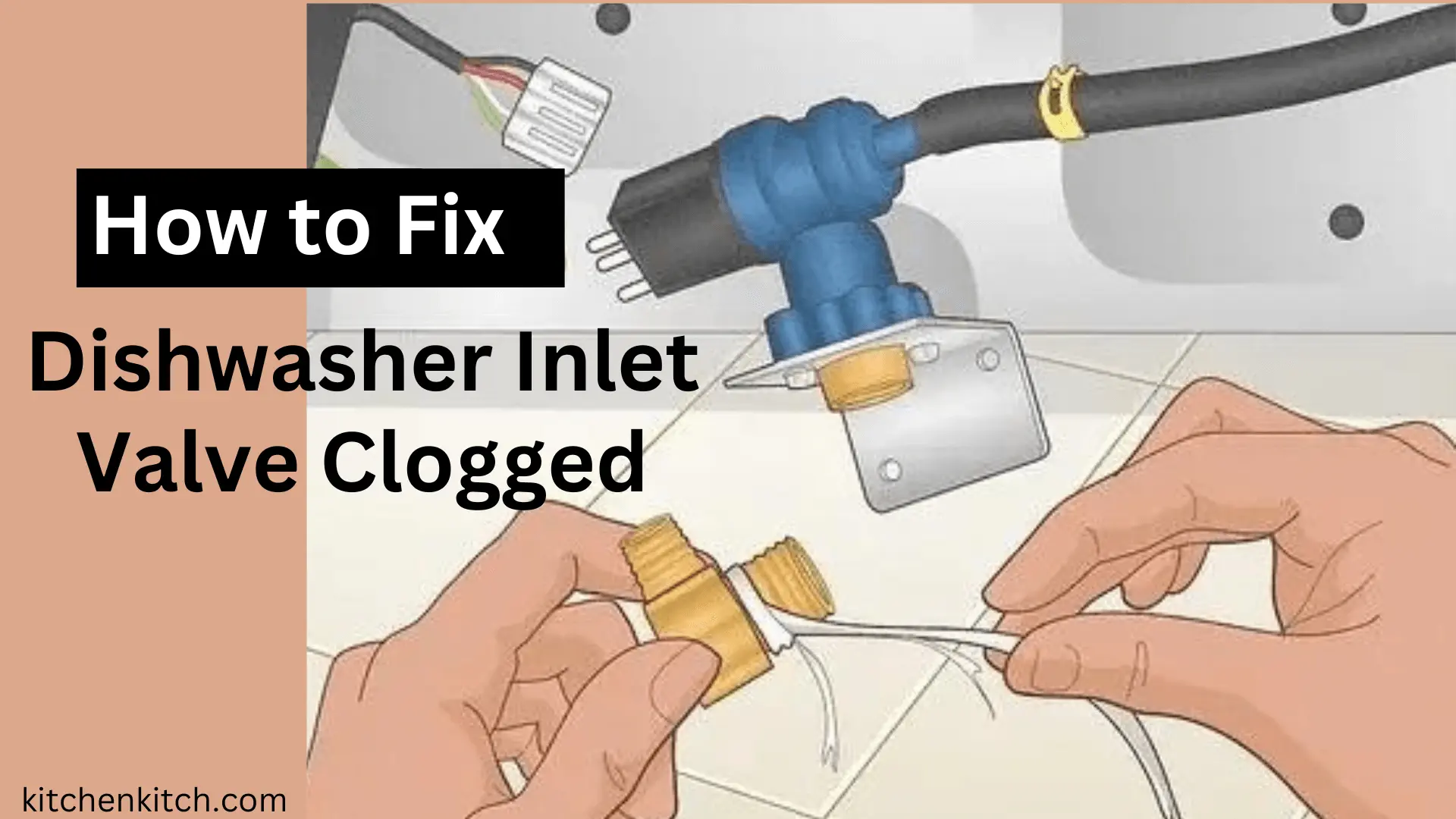How to Fix Dishwasher Inlet Valve Clogged?
At the center of today’s kitchens, dishwashers are like magical helpers, making clean-up a breeze after meals. But have you ever wondered what makes them work so smoothly? Well, it’s the dishwasher inlet valve! This little part controls how water flows in and out during the wash cycles, making sure your dishes come out sparkling clean every time. But even the best machines can have problems, and a clogged dishwasher inlet valve is one of them.
In this guide, we’ll explore why this happens, what signs to look out for, and some easy fixes you can try yourself. By understanding these issues, you’ll know how to fix dishwasher inlet valve clogged.
Common Causes of a Dishwasher Inlet Valve Clogged
A clogged dishwasher inlet valve can be caused by various factors, but some of the most common ones include:
- Hard water deposits: If your home has hard water, minerals like calcium and magnesium can build up over time and clog the inlet valve.
- Food debris: Small particles of food can get washed into the dishwasher and accumulate in the inlet valve, leading to blockages.
- Soap residue: Excess soap or detergent can leave behind residue that may block the inlet valve and hinder water flow.
- Rust or corrosion: Over time, the inlet valve may develop rust or corrosion, which can restrict water flow and cause clogs.
- Wear and tear: Like any mechanical component, the inlet valve can wear out over time, leading to problems with water flow and potential clogs.
Understanding these common causes can help you prevent clogs in the dishwasher inlet valve and maintain optimal performance. You should also know why the Kalorik Air Fryer not turning on.
Symptoms of Dishwasher Inlet Valve Clogged
Recognizing the symptoms of a clogged dishwasher inlet valve is crucial for maintaining the efficiency of your dishwasher. Here are some symptoms:
Slow or Weak Water Flow: If you notice that water is trickling into the dishwasher rather than flowing steadily, it could indicate a clog in the inlet valve. This reduced water flow can affect the cleaning performance of your dishwasher.
Incomplete Cleaning: If your dishes aren’t coming out as clean as they used to, despite running through a regular cycle, it might be due to a clogged inlet valve. Insufficient water reaching the dishwasher can result in ineffective cleaning.
Strange Noises: A clogged inlet valve can cause unusual sounds during the dishwasher’s operation. You might hear banging, clunking, or rattling noises as water struggles to pass through the obstructed valve.
Leaks or Drips: Clogs in the inlet valve can lead to pressure buildup within the dishwasher, causing leaks or drips around the appliance. Check for water pooling underneath or around the dishwasher, as this could be a sign of a clogged valve.
Error Codes: Some modern dishwashers are equipped with diagnostic systems that display error codes when there’s a problem. If your dishwasher displays error codes related to water flow or inlet valve issues, it could indicate a clog.
Failure to Fill or Drain: A severely clogged inlet valve may prevent the dishwasher from filling or draining properly. If you notice that the dishwasher isn’t filling with water at the beginning of a cycle or isn’t draining at the end, it’s likely due to a blockage in the inlet valve.
Being aware of these symptoms can help you identify and address a clogged dishwasher inlet valve promptly, ensuring your dishwasher continues to function effectively and prolong its lifespan.
How to Fix Dishwasher Inlet Valve Clogged?
Fixing a clogged dishwasher inlet valve is a task that requires careful steps to ensure it’s done right. Here’s a simple guide to help you through the process:
Step 1: Gather Your Tools
To start, you’ll need a needle-nose plier. This tool will help you clamp and manipulate parts during the process.
Step 2: Prepare the Inlet Valve
Locate the clamp attached to the hose connected to the inlet valve. Use the needle-nose pliers to squeeze the tabs together and push the clamp up the hose. This will allow you to remove the hose without misplacing the clamp.
Step 3: Remove the Inlet Valve
Once the clamp is out of the way, wiggle the hose to loosen it from the inlet valve. Once it’s free, you can pull the inlet valve out.
Step 4: Clean the Valve
Now that the inlet valve is out, you can start cleaning it. You can use needles to dislodge any debris stuck inside. Additionally, home remedies like vinegar can help dissolve stubborn clogs.
Step 5: Ensure Safety
Before you proceed, make sure to turn off the water supply to prevent any potential flooding. If your dishwasher is electric, turn off the power to avoid any accidents.
Step 6: Remove Access Panels
Depending on your dishwasher model, you may need to remove the access panel located either at the bottom or front of the dishwasher. Be sure to place a towel underneath to catch any water that may leak out.
Step 7: Disconnect Hoses
Using slip-joint pliers, unscrew the hot-water hose coupling connected to the inlet valve. Carefully slide the hose off the valve, being mindful not to damage it.
Step 8: Detach Wires and Remove the Valve
Label and disconnect the wires attached to the inlet valve terminals. Then, remove the mounting bolts holding the valve in place using an adjustable wrench.
Step 9: Install the New Valve
If the old valve is too damaged or clogged to be cleaned, replace it with a new one. Ensure the new valve matches the old one exactly before installing it.
Step 10: Reassemble and Test
Once the new valve is securely in place, reattach the wires and hoses in the reverse order of removal. Turn the water and power back on, and run a test cycle to ensure everything is working properly.
Following these steps carefully will help you effectively clean or replace a clogged dishwasher inlet valve, restoring your dishwasher’s functionality and ensuring clean dishes every time.
Maintenance and Preventive tips
Maintaining your dishwasher and implementing preventive measures can help avoid clogs in the inlet valve and ensure smooth operation. Here are some tips to keep your dishwasher in top condition:
Regular Cleaning: Clean the dishwasher’s interior, including the spray arms, filters, and door seals, regularly to prevent debris buildup that can lead to clogs. Remove any food particles or residue from the filter and spray arms after each use.
Use Quality Detergent: Use high-quality dishwasher detergent and avoid overfilling the detergent dispenser. Using too much detergent can lead to excess suds, which may contribute to clogs in the inlet valve and other components.
Maintain Water Softener: If you have hard water, consider installing a water softener system to reduce mineral buildup in the dishwasher and prevent clogs. Regularly replenish the salt in the water softener according to the manufacturer’s instructions.
Rinse Before Loading: Pre-rinse dishes to remove large food particles before loading them into the dishwasher. This helps prevent food debris from accumulating in the dishwasher and causing clogs.
Check Water Temperature: Ensure that the water temperature in your dishwasher is set to the appropriate level for optimal cleaning performance. Hot water helps dissolve detergent and remove grease and food residues effectively, reducing the risk of clogs.
Inspect Hoses and Connections: Periodically check the dishwasher’s hoses and connections for signs of leaks, cracks, or damage. Replace any worn or damaged hoses to prevent water leaks that could lead to clogs or other issues.
Run Hot Water Before Starting: Before starting a dishwasher cycle, run hot water in the sink until it reaches the desired temperature. This helps ensure that the dishwasher fills with hot water from the beginning, improving cleaning efficiency and reducing the risk of clogs.
Avoid Overloading: Avoid overloading the dishwasher with dishes, as this can obstruct the spray arms and interfere with water circulation, leading to ineffective cleaning and potential clogs.
By following these maintenance and preventive tips, you can keep your dishwasher running smoothly and minimize the risk of clogs in the inlet valve and other components. Regular maintenance not only improves cleaning performance but also extends the lifespan of your dishwasher, saving you time and money in the long run.
Conclusion
In conclusion, keeping your dishwasher’s inlet valve clean and free from clogs is essential for maintaining its efficiency. By following the maintenance and preventive tips provided, you can ensure smooth operation and extend the lifespan of your dishwasher. Regular cleaning, proper detergent usage, and checking for leaks are simple yet effective ways to prevent clogs and keep your dishwasher running smoothly for years to come.







